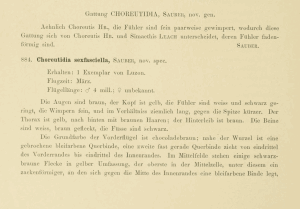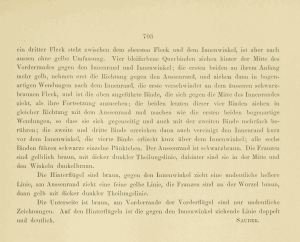

 +18Kontinente:EUASAFNAMAOC
+18Kontinente:EUASAFNAMAOC1. Lebendfotos
1.1. Falter
2. Diagnose
2.1. Erstbeschreibung
3. Biologie
3.1. Nahrung der Raupe
- [Moraceae:] Ficus microcarpa [= Ficus nitida auct.] (Chinesische Feige)
- [Moraceae:] Ficus benjamina [inkl. var. Hawaii [= Ficus hawaii] (Birken-Feige)
Rittner (2019) hatte die Raupen in Israel an Ficus sp. gesucht, war aber nicht gleich fündig geworden. Anders dann Ghonem et al. (2020: 379) aus Ägypten: "During summer of months 2020, larvae and moths of Choreutis sexfasilla [sic!] (Sauber) (Lepidoptera: Choreutidae: Choreutinae) were observed on Ficus nitida, F. benjamina and F. Hawaii trees in landscapes at Alexandria regions. It causes serious damage to Ficus trees leaves in resorts of Northern coast of Egypt since August 2020."
Und Hayden et al. (2022: 8) meldeten aus den USA: "This is an invasive pest of Ficus native to Southeast Asia. It has been established in California since 2020, where it mainly damages Ficus microcarpa L.f. The larvae skeletonize leaves, which wither and suffer necrosis."
Die Raupe lebt also - wie auch andere Arten der Gattung - an Blättern verschiedener Feigen-Arten. Da sich die Raupen auf den ersten Blick kaum voneinander unterscheiden, muss man hier zur Absicherung der Artbestimmung durchzüchten.
(Autor: Erwin Rennwald)
4. Weitere Informationen
4.1. Andere Kombinationen
- Choreutidia sexfasciella Sauber, 1902 [Originalkombination]
4.2. Synonyme
- Simaethis fulminea Meyrick, 1912 [Synonym nach funet.fi]
- Simaethis emplecta Turner, 1942
- Choreutis emplecta (Turner, 1942)
- Anthophila emplecta (Turner, 1942)
4.3. Taxonomie und Faunistik
Die Art wurde ohne nähere Ortsangabe von den Philippinen beschrieben.
Die Angabe von Meyrick (1912: 48) zu Sri Lanka betrifft das von ihm beschriebene Synonym Simaethis fulminea: "Ceylon, Trincomali, in December (Fletcher); one specimen."
Rittner (2019) meldete dann die ersten Funde aus Israel, und zwar gleich recht viele und aus verschiedenen Gegenden: Tel Aviv, Ramat HaSharon, Herzliya, Hulda, Mazkeret Batya und 'En Karem. Der erste Falter aus Tel Aviv stammt von 2016, alle anderen dann von 2019. Doch die Art könnte auch schon ein paar Jahre früher hier eingeschleppt worden sein; der Autor schreibt (S. 65): "It is unknown when and how exactly Choreutis sexfasciella arrived in Israel, and it is quite possible that the species’ distribution in Israel is wider than currently known. Import of Ficus plants from Asia may prove to be the sole source of this species in Israel. At the moment its presence does not seem to be alarming as no substantial damage to the host plants has been recorded, and there has been no report of any related observations of any kind so far. The fairly often occurrence of this species suggests that it was introduced to Israel at least several years ago and left unnoticed for a long period, most probably due to its small size and its presence in urban environments, which traditionally receive less attention of entomologists."
Rittner (2019: 63) gibt auch Informationen zur Gesamtverbreitung: "Choreutis sexfasciella (Sauber, 1902 in Semper 1896–1902) (Fig. 2) was described from the Philippines (Semper 1896–1902) and subsequently recorded from Sri Lanka (Meyrick 1912), Japan (Arita & Diakonoff 1979), Taiwan (Heppner & Inoue 1992) and Java (Savela 2019b). This is a small moth species with a wingspan measuring approximately 10 mm. In recent years it has been observed and collected in Israel in several localities, thus becoming the second species of metalmark moths in Israel. This is also the first report of Ch. sexfasciella outside the Oriental Region."
Und es sollte nicht lange dauern,bis die erste Meldung aus Ägypten kam: Ghonem et al. (2020: 379) meldeten aus Ägypten: "During summer of months 2020, larvae and moths of Choreutis sexfasilla [sic!] (Sauber) (Lepidoptera: Choreutidae: Choreutinae) were observed on Ficus nitida, F. benjamina and F. Hawaii trees in landscapes at Alexandria regions. It causes serious damage to Ficus trees leaves in resorts of Northern coast of Egypt since August 2020. This small metalmark moth is recorded for the first time in Egypt."
In der Einführung S. 379 ist zudem zu lesen: "This identification was kindly confirmed by Dr. Jadranka Rota, Biological Museum entomology curator, Sweden who reported that this insect was not only first arrival in Egypt, but also it is spreading in Africa from Asia." Weitere Länder Afrikas wurden dabei leider nicht genannt.
Bippus (2020: 71) meldete ebenfalls für 2020 die ersten beiden Exemplare von Réunion - ob hier Verschleppung (was anzunehmen ist) oder mehr oder weniger natürliche Ausbreitung dahintersteckt, muss sich noch klären: "Two males were captured in Réunion, La Possession, alt.400m, 20°55'37''S/55°21'45''E on 21.i.2020 (gen. prep. RE-4080) and 11.iv.2020. This species seems to exist also in Papua New Guinea but the specimens are not illustrated (www.boldsystems.org). Distribution: Australia, Papua New Guinea and Réunion (new record)."
Wenig überraschend wurde die Art nicht nur in den Nahen Osten verschleppt, sondern auch ins südliche Nordamerika. Auf [mothphotographersgroup.msstate.edu [abgefragt 7. Januar 2024]] ist zu lesen: "Choreutis sexfasciella (Sauber, 1902) is now recognized within the North American fauna north of Mexico with multiple reports from southern California. Originally reported as Choreutis emplecta, the names were synonymized in Heppner (2023). Although emplecta was transferred to Anthophila in Bippus (2020), Heppner retained sexfasciella in the genus Choreutis and disagrees with the generic treatment in Bippus (2020) (Heppner, pers. comm. 6 Jan 2024). This species is also reported from Florida in Hayden et al. (2022)."
Hayden et al. (2022: 8) schrieben zum Erstnachweis in Florida: "This is an invasive pest of Ficus native to Southeast Asia. It has been established in California since 2020, where it mainly damages Ficus microcarpa L.f. The larvae skeletonize leaves, which wither and suffer necrosis. The moths in Florida were photographed first by a member of the public, who collected and submitted a specimen to FDACS-DPI for verification. The genitalia match those of C. sexfasciella, and the COI barcode data are 100% consistent with the population in California. Photographs online suggest this moth is spreading rapidly in southeastern Florida. (Palm Beach County; E5602-01-12072022-10725; Mr. Shawn Roller; 24 November 2022.) (Dr. James E. Hayden, Dr. John B. Heppner, Matthew R. Moore.)"
Die Art könnte sich also durchaus auch noch im südlichen Europa breit machen. Vor allem war sie erst einmal auf Zypern zu erwarten. Und tatsächlich fotografierte Wayne Tucker (alias "snapp3r") am 7. Oktober 2023 einen Falter, den er auf [iNaturalist] als diese Art bestimmte - womit man ihm Recht geben muss. Vorläufig alo ein Einzelfund, aber die Art wurde bestimmt nicht zum letzten Mal in Europa notiert.
Die auf iNaturalist mit Bildern gemeldeten Funde aus den Vereinigten Arabischen Emiraten, aus Malaysia und Thailand sind überzeugend, einige andere bedürfen noch der Absicherung.
(Autor: Erwin Rennwald)
4.4. Literatur
- Bippus, M. (2020): Records of Lepidoptera from the Malagasy region with description of new species (Lepidoptera: Tortricidae, Noctuidae, Alucitidae, Choreutidae, Euteliidae, Gelechiidae, Blastobasidae, Pterophoridae, Tonzidae, Tineidae, Praydidae, Cosmopterigidae, Batrachedridae). — Phelsuma, 28: 60-100. [PDF auf islandbiodiversity.com]
- Ghonem, A., Ramadan, H., El-Abed, Y.G. & D.A. Elsakhawy (2020): New record of Oriental Metalmark Moth Choreutis sexfasciella (Sauber) (Lepidoptera: Choreutidae: Choreutinae) in Egypt. — Alexandria Journal of Agricultural Sciences, 65 (6): 379-383. [PDF auf alexja.journals.ekb.eg]
- Hayden, J.E., Heppner, J.B. & M.R. Moore (2022): Choreutis sexfasciella (Sauber), a choreutid moth, a new Florida state record. — Tri-ology, 61(4): 8. [PDF auf ccmedia.fdacs.gov]
- Heppner, J.B. (2023): Choreutis sexfasciella introductions in southern California and Florida (Lepidoptera: Choreutidae: Choreutinae). — Lepidoptera Novae, 16: 49-54. [Sekundärzitat]
- Beschreibung als Simaethis fulminea: Meyrick, E. (1912): Exotic Microlepidoptera 1: 1-640. [London] (Taylor & Francis). [Digitalisat auf biodiversitylibrary.org]
- Rittner, O. (2019): The first documented report of metalmark moths (Lepidoptera: Choreutidae) in Israel, with the first record of Oriental Choreutis sexfasciella (Sauber) in the Palearctic. — Israel Journal of Entomology 49 (1): 63-67. [PDF auf ij-entomology.online]
- Erstbeschreibung: Semper, C. (1902): Die Schmetterlinge der Philippinischen Inseln. Beitrag der Indo-Malayischen Lepidopteren-Fauna. Zweiter Band: Die Nachtfalter. Heterocera. Sechste Lieferung: 625-728, pl. LXV-LXVI, pl. U-V. Wiesbaden (C. W. Kreidel's Verlag).





















